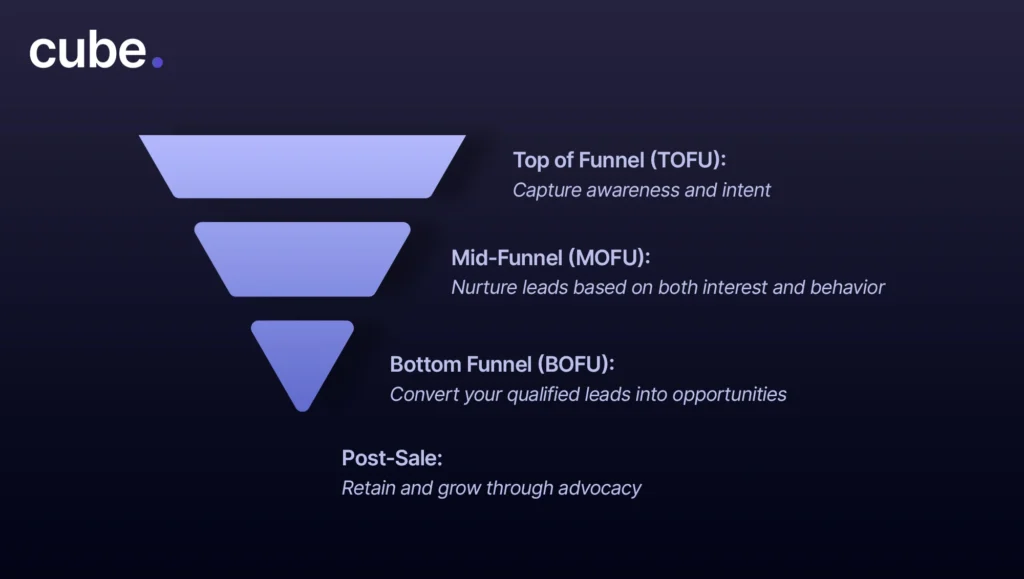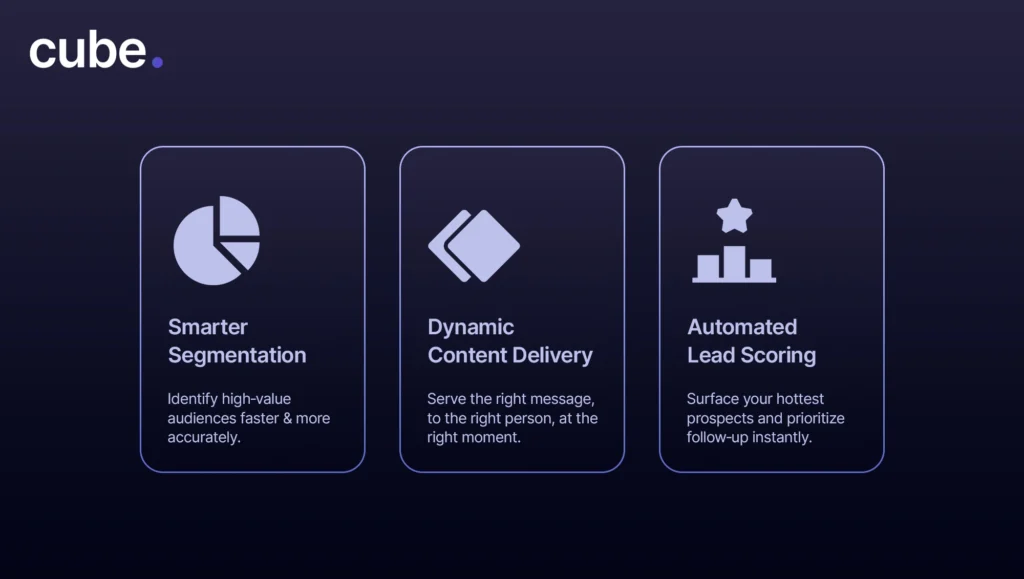In enterprise business, paid marketing is less about outspending competitors and more about outsmarting them. User behavior is changing rapidly, and touchpoints are dispersed across devices, platforms, and channels. This means that traditional marketing funnels are falling apart: the controlled, linear, slow-moving marketing funnel is losing its effectiveness.
We are in the era of AI marketing automation – agile, predictive, and incessantly data-oriented. So, rather than relying on traditional, outdated funnels, enterprises need to rethink the way they create funnels that convert leads to customers and customers into community members.
This guide will explore how entrepreneurs can leverage intelligent, tailored paid funnels and AI to develop predictable, scalable lead generation. We will break down what each stage of the funnel looks like, identify the necessary tools, and demonstrate how to integrate automation with strategy.
What Is an AI-Driven Paid Marketing Funnel?
An AI-powered funnel uses the latest AI technology at every stage to be more efficient, relevant, and produce better outcomes. Instead of a linear funnel that takes leads from awareness to conversion, they adapt in real time to user behavior.
This way, with every funnel stage, leads can be targeted more accurately (top), dynamically retargeted and served personalized content based on their engagement (middle), and aided in lead scoring, qualification, and conversion (bottom).
And the best part about AI is that it learns in real-time. Throughout the campaigns we run, our in-house learns insights, targets leads, manages budgets, and evolves our creative approach with very little human interaction.
Mapping the Enterprise Funnel: A Multi-Touch Journey
Enterprise lead generation is not a click-and-convert game. It is a complex, multi-touch journey with lengthy sales cycles, multiple stakeholders, and substantial budgets.
Here is a breakdown of the funnel:

A smart campaign segments campaigns by buyer intent and funnel stage instead of just demographic and industry segments. And AI can help automate this segmentation by leveraging data signals across multiple platforms.
Top of Funnel (TOFU): Smart Awareness Campaigns with AI
The purpose of the awareness stage is simple: to garner attention from your key audience. But in an enterprise environment, “attention” conveys more than just impressions or clicks. It requires meaningful engagement from decision-makers at the right companies.
AI refines this process by identifying high-performing channels for awareness. Through predictive modeling, AI has extensive knowledge of industry trends and historical data of all platforms (Google, LinkedIn, Meta, and Amazon).
With new tools such as Meta Advantage+ and Google Performance Max, you can create creative variations to scale, automatically A/B test your performance, and optimize in real time. These platforms assess engagement patterns to figure out what messaging works best and which audiences are worth retargeting.
TOFU campaigns are data collection engines. Even if they don’t convert users into immediate customers, there is value in the data with regard to what content, channels, and creative formats are performing best.
Mid-Funnel (MOFU): Nurturing Enterprise Leads at Scale
Enterprise marketing teams often lose momentum in the mid‑funnel, as promising leads slip through the cracks. They often grow cold amid inconsistent or off‑target outreach. By harnessing AI‑driven automation, you can deliver timely, hyper‑relevant nurturing at scale, ensuring every prospect receives the right message at the right moment to accelerate their journey toward conversion.
AI-powered segmentation allows marketing teams to categorize leads based on various engagement signals like website visits, content downloads, or pages with the most time spent. This will then trigger a dynamic retargeting ad or personalized email sequence.
If a lead has visited the product demo landing page a few times, AI tools allow for a relevant case study to be linked or an invitation to the webinar to be sent. If the lead engages, they move further down the funnel; if not, we send them different content with retargeting.
This is also where we should have email and paid ads working together. A marketing automation platform can trigger drip campaign emails and retarget with ads to provide a coordinated experience across multiple touchpoints.
AI makes sure we put the right content in front of each lead in their funnel stage and their specific vertical or business problem.
Bottom Funnel (BOFU): Converting Qualified Enterprise Prospects
At the bottom of the funnel, the focus is solely on leveraging engagement with a lead, in other words, sales opportunities. Here, AI helps with lead quality scoring and campaign sequencing to maximize close rates.
AI-assisted Lead scoring scores each contact based on behavior, engagement, firmographics, and other signals of intent. Leads that receive a high-quality lead score are ideally scored first for sales engagement, while lower scores may be nurtured further or re-engaged down the line. Sequential ad messaging becomes paramount at this stage.
Instead of single offer ads, AI systems sequence targeted messages one after another, helping to address objections, build urgency, and finally, get them to do something. A white paper ad, followed by a testimonial video, and finally a limited-time offer on a demo.
CRM alignment is also very important. Platforms like Cube AI ensure that marketing and sales are aligned. When your pipeline data integrates into your paid campaign, you open abilities for AI to factor spend in ways it couldn’t, such as retargeting leads that stalled in your pipeline, re-engaging deals that have gone cold, and allocating spend to actionable targets, like a high-value account.
Key Metrics to Track in an AI-Powered Funnel
AI creates opportunities for optimization in real time, but only if you are analyzing the right data.
Metrics by Funnel Stage
- TOFU: Cost per Lead (CPL), Impressions to Clicks
- MOFU: MQL to SQL Conversion Rate, Engagement Scores
- BOFU: Pipeline Velocity, Time to Close, ROAS
Smart Attribution with Cube AI
- Don’t limit yourself to the last touch. Use multi-touch models to understand the full picture.
- Bring together data from Google, Meta, LinkedIn, CRM, and website tools.
- Create feedback loops: the more the funnel learns, the smarter it becomes.
Challenges & How to Overcome Them
While AI is certainly a powerful tool, it’s not magic. Smart funnels require a smart strategy. Here are a couple of common issues to look out for:
1. Data silos: Bridge your tools together with APIs and Zapier or Segment.
2. Low-quality leads: Revisit your targeting models and train AI with enriched first-party data.
3. Over-automation: Don’t depend on Smart Campaigns alone. AI can enhance your strategy, not replace it.
4. Privacy compliance: Use logic and personalization based on opt-in consent that follows GDPR and CCPA standards.
Real Results: What AI Funnels Can Do for Enterprises
When you embrace AI-enabled funnels, you can measure immediate results. Campaigns become smarter, budgets are maximally stretched, and teams can spend less time manually managing friction points and more time on strategic elevation.
Consider running multiple paid campaigns on LinkedIn, YouTube, and Google, all enhanced and optimized in real time – leads scored automatically, sales instantly alerted, and content designed for follow-up sent without missing a beat. Not only does AI help to eliminate waste, but it also helps to drive down the time from lead to deal.
If you’re not using AI, you’re guessing. If you ARE using AI, you are learning and scaling.
Reimagining the Paid Funnel with AI
The era of one‑size‑fits‑all marketing funnels is over. To thrive in enterprise marketing today, you need a funnel that’s intelligent, agile, and driven by real‑time data.
CubeAI engine automates and optimizes every stage of your paid funnel:

The result? Higher‑quality leads, accelerated conversions, and maximum ROI on your ad spend.
Are you ready to future‑proof your paid marketing? Request your custom ad funnel audit today, and discover how AI can unlock breakthrough performance for your campaigns.


